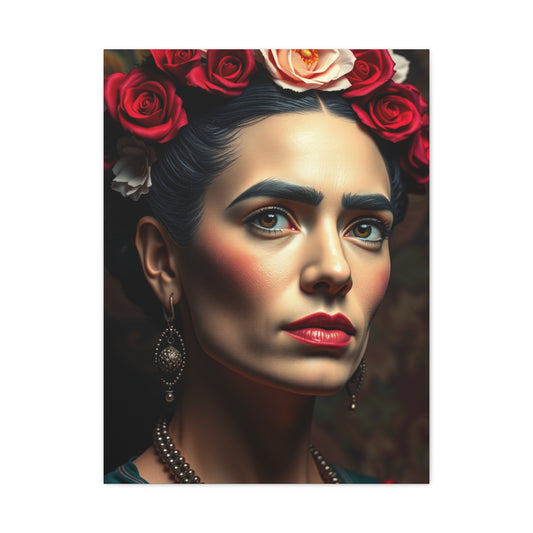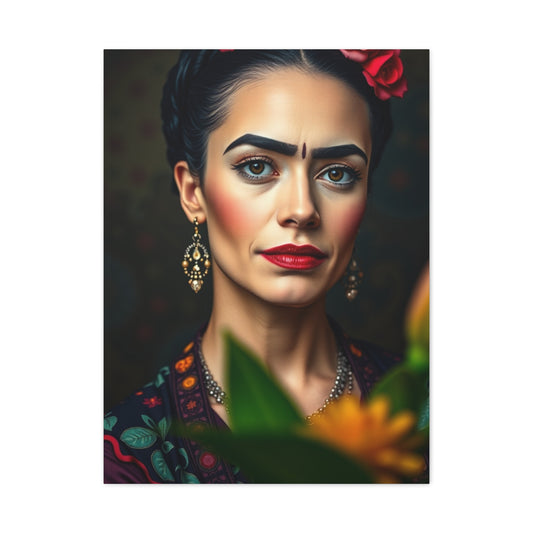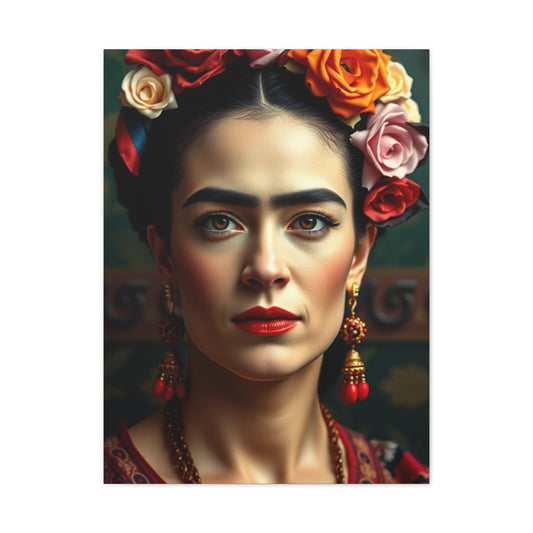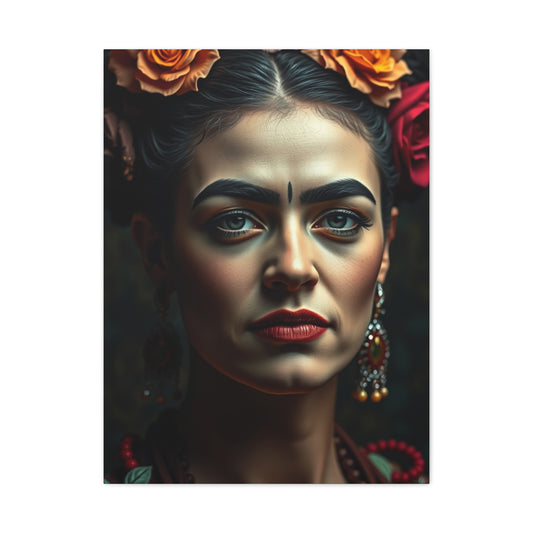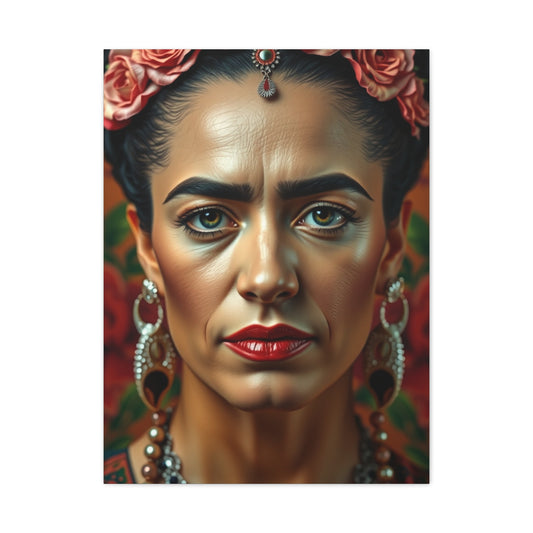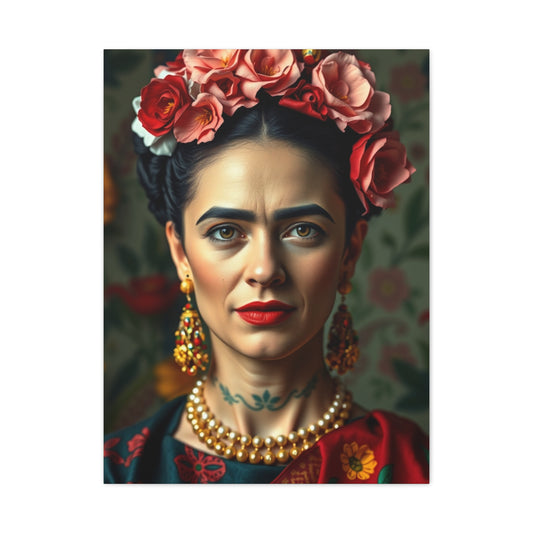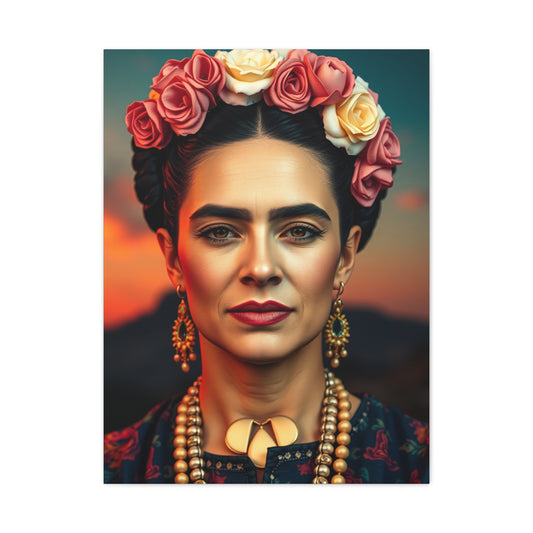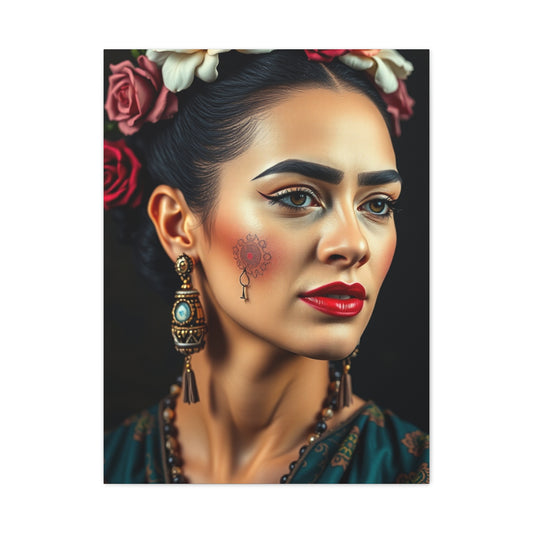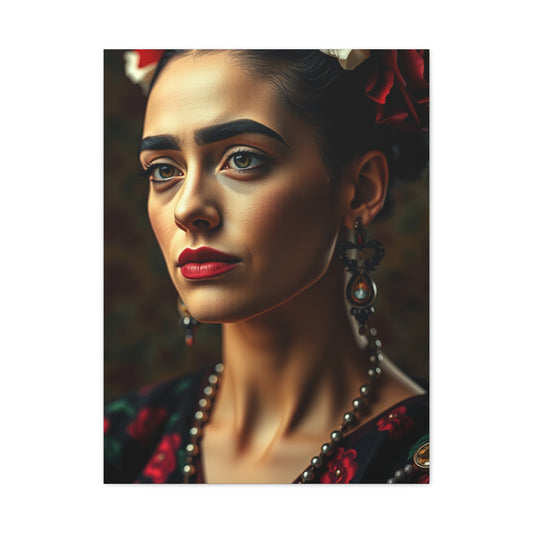Redefine Your Living Space with Captivating Frida Kahlo Wall Art
Frida Kahlo, the celebrated Mexican painter, has long transcended the boundaries of time and geography, leaving an indelible imprint on the world of contemporary art. More than just a painter, Kahlo represents the intersection of resilience, self-expression, and the intricate exploration of personal identity. Her work has continued to captivate audiences decades after her passing, inspiring artists to embrace authenticity, vulnerability, and imagination within their own creative endeavors. The scope of her influence is remarkable, encompassing not only stylistic elements but also philosophical approaches to art and life.
Central to Kahlo’s legacy is her profound ability to fuse art with lived experience. Unlike many artists who maintain a separation between life and artistic output, Kahlo transformed her existence into visual narratives, crafting images that reflected both her inner world and external circumstances. Her self-portraits, which constitute a significant portion of her oeuvre, are intensely autobiographical, capturing emotions and experiences with unflinching honesty. The hardships she endured—polio in childhood, followed by a devastating bus accident that resulted in numerous fractures and lifelong medical complications—did not inhibit her creativity. Instead, they became a source of inspiration, informing the thematic richness and emotional depth of her work.
Through this intimate connection between life and art, Kahlo pioneered a methodology that contemporary artists continue to emulate. Her paintings are immersive, compelling viewers to engage with complex emotional landscapes, often blurring the boundaries between reality and imagination. She demonstrated that art could serve as a conduit for personal catharsis while simultaneously resonating on a universal scale. Modern artists frequently draw upon autobiographical elements in their work, creating pieces that evoke empathy and reflection, a testament to the enduring relevance of Kahlo’s approach.
Symbolism occupies a central role in Kahlo’s visual language. Her canvases are populated with meticulously chosen objects, flora, fauna, and abstract motifs, each imbued with layered meaning. From thorned vines and vivid flowers to monkeys and birds, her imagery conveys emotions and ideas that often elude verbal articulation. Contemporary creators continue to harness the potency of symbolic representation, employing fantastical and metaphorical elements to explore themes of identity, gender, and societal structures. Kahlo’s pioneering use of symbolism demonstrates how visual elements can communicate intricate narratives and complex emotional states, offering contemporary artists a framework for translating internal experience into visual form.
The surrealist dimension of Kahlo’s work further amplifies her influence. Although she resisted being confined to the surrealist label, the dreamlike quality of her paintings—where fantastical and tangible elements coexist—has left an indelible mark on modern art. Her employment of surrealist techniques was not a mere stylistic flourish but a vehicle for exploring psychological and existential terrains. By juxtaposing realistic depictions of the human body with symbolic or imaginary components, Kahlo examined themes of corporeality, mortality, and consciousness. Contemporary artists similarly adopt these methods to probe the subconscious, interrogate memory, and challenge conventional perceptions of reality, echoing Kahlo’s nuanced approach.
Equally significant is Kahlo’s fearless exploration of femininity and the female experience. At a time when artistic conventions often relegated women to idealized or passive roles, she foregrounded the corporeal and emotional dimensions of womanhood. Her self-portraits candidly depicted physical scars, reproductive experiences, and personal desires, disrupting societal norms regarding female beauty and propriety. This radical honesty empowered women artists to assert agency in both thematic and stylistic dimensions, inspiring generations to challenge traditional representations of gender and to embrace the complexity of feminine identity.
Kahlo’s work is also inseparable from her sociopolitical convictions. She championed indigenous rights, gender equality, and social justice, integrating these concerns into her paintings with subtlety and sophistication. Her art demonstrates that creative expression can function as a form of activism, conveying powerful social commentary without sacrificing aesthetic integrity. Contemporary artists continue to follow this model, addressing pressing global issues through their work, from environmental degradation to human rights violations. In this way, Kahlo’s legacy extends beyond artistic technique to encompass ethical and civic engagement, encouraging creators to produce work that is both aesthetically compelling and socially resonant.
Pain, resilience, and aesthetic innovation form the backbone of Kahlo’s artistic universe. Her influence on contemporary art is multifaceted, encompassing more than mere stylistic imitation. Kahlo exemplified the principle that art is inseparable from personal experience, that individual truths can illuminate collective understanding, and that visual expression can challenge societal norms while celebrating individuality. For contemporary artists grappling with the complexities of identity, culture, and emotion, her example offers a blueprint for integrating introspection, audacity, and imagination into their creative practices.
The integration of personal narrative into her artwork creates a profound dialogue between artist and audience. Each painting functions as a vessel for emotional exploration, offering viewers an intimate glimpse into Kahlo’s lived experiences while inviting reflection on universal human conditions. This immersive quality fosters empathy and encourages audiences to confront their own vulnerabilities, a dynamic that contemporary artists continue to cultivate in diverse media. Kahlo’s insistence on authenticity has demonstrated that the emotive resonance of a work often surpasses technical mastery in creating meaningful artistic impact.
Symbolism in her work further amplifies its communicative power. Kahlo’s use of objects, natural elements, and abstract motifs transcends decorative purpose; each component serves a narrative or psychological function. Flowers, often depicted in vivid colors and lush compositions, signify vitality, femininity, and the transience of life. Animals, such as monkeys and birds, convey companionship, instinctual behavior, or emotional states. These symbolic elements enable her to convey layered meanings with remarkable clarity, an approach that continues to inspire artists who seek to explore the interplay of metaphor, allegory, and visual storytelling.
Her subtle incorporation of surrealist techniques enhances the emotional and psychological depth of her work. By merging realistic portrayals of the human form with fantastical or symbolic elements, Kahlo created paintings that operate simultaneously on multiple levels of interpretation. Contemporary artists draw on these strategies to explore internal landscapes, navigate memory, and interrogate the boundaries between conscious and unconscious thought. The dreamlike quality of her work, though often unsettling, provides an expansive framework for contemporary creative exploration, underscoring the enduring relevance of her aesthetic vision.
Kahlo’s exploration of femininity and the female experience remains a defining aspect of her legacy. She rejected conventional standards of beauty, portraying her physical scars, personal struggles, and reproductive experiences with candid intimacy. This fearless representation of womanhood resonated with other women artists, who found in her work a model for asserting agency and expressing the multifaceted dimensions of gender identity. Contemporary creators continue to draw inspiration from Kahlo’s audacity, foregrounding themes of bodily autonomy, female desire, and social critique in their own art.
Moreover, her political engagement illustrates the potential of art to intersect with activism. Kahlo’s advocacy for indigenous communities, gender equity, and social justice permeated her visual language, demonstrating that aesthetic expression can serve as a medium for public discourse and ideological challenge. Modern artists frequently emulate this integration of art and activism, using visual narratives to raise awareness, critique societal inequities, and inspire cultural reflection. Kahlo’s legacy underscores that art need not exist in isolation; it can engage with social realities and foster meaningful dialogue.
In essence, Frida Kahlo’s influence on contemporary art extends far beyond stylistic emulation. Her commitment to authenticity, her rich symbolic vocabulary, and her nuanced exploration of femininity and social consciousness collectively inform the practices of modern creators. Artists today continue to navigate identity, emotion, and imagination through frameworks established in part by Kahlo’s pioneering work. She exemplifies the transformative potential of art, demonstrating how personal truth can illuminate universal experience and how creativity can challenge convention, amplify marginalized voices, and engage with pressing societal issues.
Kahlo’s body of work is a testament to the power of visual storytelling, offering insight into both the individual and collective human condition. By intertwining autobiography, symbolism, surrealism, and political consciousness, she created a multidimensional artistic language that resonates across generations. Contemporary artists who integrate personal experience, social engagement, and imaginative expression into their work continue to affirm the relevance of her vision. In doing so, they perpetuate a legacy that is both timeless and profoundly influential.
Ultimately, Frida Kahlo’s enduring allure lies in her capacity to articulate the complexities of life with candor, creativity, and philosophical depth. Her paintings are not only aesthetically compelling but also emotionally resonant, offering viewers a window into the intricate interplay of pain, resilience, and beauty. By weaving her lived experience into visual form, she created a paradigm in which art becomes a mirror of the human condition. For contemporary artists and audiences alike, her work exemplifies the potential of art to inspire, challenge, and transform, leaving a legacy that continues to illuminate the creative landscape.
Frida Kahlo’s Life, Struggles, and the Formation of a Unique Artistic Vision
Frida Kahlo’s life was a tapestry woven with resilience, adversity, and artistic ingenuity. From her early years, she encountered challenges that would profoundly shape her worldview and artistic sensibilities. Born in 1907 in Coyoacán, Mexico, she navigated a childhood complicated by polio, which left her with lasting physical effects, instilling in her a keen awareness of bodily vulnerability and human fragility. These early encounters with illness and limitation became integral to her understanding of corporeal experience, which she would later translate into her vivid, emotive paintings.
Her adolescent years coincided with the aftermath of the Mexican Revolution, a period marked by social upheaval and cultural transformation. Kahlo absorbed the spirit of nationalism and the resurgence of indigenous cultural pride, which became enduring motifs in her art. The confluence of personal and political histories provided fertile ground for her creative imagination, allowing her to blend autobiographical experiences with broader cultural narratives. This integration of self and society became a defining characteristic of her artistic vision, one that continues to influence contemporary creators seeking to explore the interplay between personal identity and cultural context.
In 1925, a catastrophic bus accident altered the trajectory of Kahlo’s life. She suffered multiple fractures, a shattered pelvis, and severe injuries that necessitated more than thirty surgical procedures over the course of her lifetime. During the extended periods of convalescence, she began painting with a fervent intensity, turning her physical suffering into a channel for creative expression. The intimate and often painful nature of her work stemmed directly from these experiences, as she confronted the limitations and vulnerabilities of the human body with unflinching honesty. Pain, for Kahlo, became both a subject and a medium, allowing her to convey physical and emotional realities with extraordinary clarity.
It was during these years of recovery that Kahlo developed the distinctive techniques and stylistic sensibilities that would define her oeuvre. Her self-portraits, which now constitute a significant portion of her body of work, emerged from a necessity to document and explore her own identity in the face of suffering. She painted herself with an unvarnished authenticity, capturing both her physical scars and emotional states. These portrayals diverged from traditional representations of female beauty, reflecting an audacious defiance of societal expectations. The resulting compositions were simultaneously intimate, confrontational, and profoundly symbolic, setting a precedent for subsequent generations of artists to explore personal narrative in their work.
Kahlo’s engagement with cultural symbolism and indigenous aesthetics also took shape during this formative period. She drew inspiration from pre-Columbian art, Mexican folk traditions, and the vibrant imagery of local flora and fauna. This synthesis of historical, cultural, and personal motifs created a visual language that was uniquely her own. Contemporary artists often reference this holistic approach, recognizing the power of blending autobiographical experience with broader cultural and historical influences to create art that resonates on multiple levels. Kahlo’s ability to imbue her paintings with cultural specificity while addressing universal themes of pain, identity, and desire exemplifies her enduring relevance.
The development of her artistic identity was further influenced by her tumultuous personal relationships, most notably her marriage to Diego Rivera, the prominent Mexican muralist. Their relationship was marked by passion, infidelity, and creative collaboration, each element leaving an imprint on her artistic output. Rivera encouraged Kahlo’s experimentation, yet their dynamic also intensified the emotional complexity of her work, as her paintings frequently reflected the joys and sorrows inherent in their union. Contemporary artists continue to explore the influence of intimate relationships on creativity, drawing upon Kahlo’s example to interrogate how love, loss, and interpersonal dynamics can shape artistic expression.
Kahlo’s health challenges continued throughout her life, influencing both her subject matter and her stylistic evolution. Confinement to a wheelchair or bed for extended periods afforded her ample time for introspection, allowing her to delve into the intricacies of selfhood, mortality, and corporeality. This physical immobility paradoxically expanded the scope of her creative imagination, as she used painting to transcend the limitations imposed by her body. Her focus on the self, combined with symbolic and surrealist imagery, created a body of work that is simultaneously autobiographical and allegorical, offering viewers an intricate exploration of the human experience.
The motifs that recur in Kahlo’s work—flora, fauna, anatomical elements, and folkloric imagery—emerged during these years of introspection. Flowers, in particular, became a persistent symbol of life, growth, and ephemerality, often juxtaposed with imagery of pain, decay, or mortality. Animals, including monkeys, birds, and dogs, frequently served as companions or symbolic extensions of emotional states. These elements collectively constructed a visual lexicon capable of conveying complex emotional and psychological narratives. Contemporary artists often employ similar symbolic devices, drawing upon Kahlo’s methodology to create rich, multilayered compositions that engage with both personal and societal themes.
Kahlo’s self-portraits are particularly striking for their dual function as personal documentation and social commentary. They confront viewers with the realities of bodily vulnerability, illness, and human suffering, while simultaneously addressing broader cultural and political contexts. Her portrayal of physical scars, reproductive experiences, and emotional turmoil challenged normative conceptions of femininity and beauty. By presenting herself in an unflinching and unapologetic manner, she disrupted conventional narratives about the female body and its representation in art. This audacity has inspired generations of women artists to explore similar themes, asserting agency over their own representations and confronting societal expectations with creative assertiveness.
The interplay between personal suffering and artistic creation in Kahlo’s life illustrates the transformative potential of art. Pain became a medium through which she could articulate inner realities, transforming physical and emotional adversity into images of extraordinary power and resonance. Her approach exemplifies the capacity of art to bridge the gap between personal experience and collective understanding, offering both catharsis for the artist and empathy for the audience. Contemporary artists frequently draw upon this model, recognizing that authenticity, vulnerability, and emotional candor can imbue creative work with lasting significance.
Kahlo’s fascination with the human body extended beyond personal experience to broader philosophical and existential considerations. She explored themes of mortality, regeneration, and corporeal identity with a precision and depth that were remarkable for her time. Her anatomical depictions, often combined with surrealist or symbolic elements, interrogated the boundaries between physical reality and psychological experience. By placing the self at the center of her artistic inquiry, Kahlo pioneered a mode of introspective, embodied art that continues to resonate in contemporary practice. Artists today who investigate the interplay between the body, identity, and emotion often do so in ways that echo Kahlo’s pioneering explorations.
Equally important to the formation of her artistic vision was Kahlo’s engagement with Mexican culture and folklore. She embraced indigenous aesthetics, vibrant colors, and traditional symbolism, incorporating these elements into her paintings to craft a distinctly Mexican visual identity. This cultural rootedness did not limit the universality of her work; rather, it enriched it, providing layers of meaning that resonate both locally and globally. Contemporary artists frequently draw upon similar strategies, integrating cultural heritage with personal narrative to produce art that is simultaneously specific and universal, grounded in identity yet transcendent in its emotional and conceptual reach.
The emotional intensity of Kahlo’s work reflects her philosophical commitment to authenticity and self-exploration. Her paintings often depict intimate and sometimes painful moments, presenting viewers with a candid vision of her internal life. By refusing to sanitize or idealize her experiences, she established a precedent for modern artists to embrace vulnerability as a powerful tool for communication. This radical honesty has become a hallmark of contemporary autobiographical and expressive art, encouraging creators to explore personal histories, traumas, and desires with clarity and courage.
Her life, marked by physical suffering, emotional turbulence, and social engagement, provided a unique crucible for artistic development. Each challenge and triumph informed the content and style of her work, resulting in a body of paintings that is intensely personal, yet universally resonant. The synthesis of experience, symbolism, and imagination in her oeuvre established a model for contemporary art in which narrative depth, psychological acuity, and cultural awareness coexist harmoniously. Kahlo’s example demonstrates that an artist’s life can be as integral to their work as their technical skill, creating a dynamic interplay between biography and creative expression.
Symbolism, Surrealism, and the Language of Imagery in Frida Kahlo’s Art
Frida Kahlo’s paintings are widely recognized not only for their intimate autobiographical content but also for their intricate symbolic and surrealist language. Her use of metaphor, allegory, and dreamlike imagery created a visual lexicon capable of expressing emotions, experiences, and philosophical ideas that often elude conventional articulation. In her work, the personal, the cultural, and the psychological converge, producing a multidimensional artistic universe that continues to inspire contemporary creators seeking to navigate the boundaries between reality, imagination, and self-expression.
Symbolism in Kahlo’s art is profound, pervasive, and deliberate. Each element within her canvases carries layered meaning, functioning as both narrative device and psychological indicator. Flora and fauna frequently recur, often serving as allegories for emotional states, mortality, and regeneration. Flowers, rendered in bold, vibrant colors, symbolize vitality, fertility, and the ephemeral nature of life. Birds, monkeys, and other creatures often represent companionship, instinctual behavior, or the projection of internal psychological states. By employing these symbols, Kahlo transformed everyday imagery into conduits for complex expression, allowing viewers to decipher personal, social, and existential narratives embedded in her compositions. Contemporary artists often adopt a similar approach, using symbolic imagery to convey intricate ideas and forge emotional connections with audiences.
Surrealism is another defining dimension of Kahlo’s work, though she often resisted being labeled strictly within the movement. Her art exhibits hallmarks of surrealism—the blending of reality and fantasy, the juxtaposition of ordinary and extraordinary elements, and the evocation of dreamlike states—yet it remains deeply rooted in personal experience. Unlike traditional surrealists who pursued automatic or subconscious creation, Kahlo’s surrealism emerges from deliberate reflection and autobiographical intent. By combining realistic depictions of the human body with fantastical and symbolic elements, she explored internal landscapes, physical suffering, and emotional complexity with extraordinary nuance. Contemporary artists frequently draw inspiration from this method, employing surrealist techniques to probe consciousness, memory, and identity while maintaining narrative clarity and emotional resonance.
An examination of Kahlo’s self-portraits reveals the intersection of symbolism and surrealism most vividly. In these works, the human body functions as a canvas for personal, psychological, and cultural expression. Anatomical elements, scars, and physical deformities are depicted with unflinching realism, while symbolic and surreal motifs—such as thorned vines, floating animals, or radiant floral arrangements—imbue the compositions with deeper meaning. This juxtaposition of corporeal accuracy and imaginative flourish allows Kahlo to navigate themes of pain, mortality, identity, and desire simultaneously. Contemporary artists frequently emulate this strategy, using self-representation and symbolic layering to interrogate the relationships between body, psyche, and society.
Kahlo’s use of natural elements, particularly flora and fauna, exemplifies her sophisticated symbolic system. Flowers are not merely decorative; they are emblems of life’s fragility, fertility, and regenerative potential. Monkeys, which recur in several self-portraits, function both as playful companions and metaphors for emotional dependency or instinctual drives. Birds, dogs, and other animals similarly serve dual purposes, combining literal representation with psychological subtext. By integrating these motifs, Kahlo established a visual grammar capable of communicating complex emotional, cultural, and philosophical narratives. Contemporary visual artists often adopt analogous strategies, using layered symbolism to articulate nuanced themes and elicit interpretive engagement from their audience.
In addition to fauna and flora, Kahlo frequently employed surreal or fantastical elements to enhance narrative and emotional depth. Floating objects, fragmented forms, and dreamlike juxtapositions appear across her oeuvre, often referencing inner psychological states or existential questions. Surrealist components in her work facilitate exploration of dualities—life and death, pleasure and pain, corporeal reality and imagination—creating a multidimensional framework that challenges viewers’ perceptions. This integration of realism and fantasy has inspired modern artists to approach surrealism not merely as stylistic embellishment but as a tool for introspection, narrative expansion, and emotional resonance.
Color and composition play equally important roles in Kahlo’s symbolic and surrealist language. Her palette is often bold, vibrant, and saturated, reflecting the intensity of her emotional and cultural milieu. Vivid reds, deep greens, and luminous blues punctuate her canvases, evoking both psychological tension and cultural specificity. Compositionally, she often employs frontal, symmetrical arrangements that confront the viewer directly, creating an intimate and immersive experience. Contemporary artists frequently study Kahlo’s mastery of chromatic intensity and compositional balance, recognizing how these elements amplify both symbolic meaning and emotional impact.
Another significant aspect of Kahlo’s visual language is her integration of Mexican folk traditions and indigenous aesthetics. She frequently incorporated motifs derived from pre-Columbian art, indigenous symbolism, and traditional craft, weaving these cultural references into her personal narratives. This blending of personal and cultural symbolism created a uniquely Mexican visual identity while addressing universal themes such as pain, resilience, love, and mortality. Contemporary artists often draw inspiration from this synthesis, demonstrating how the integration of heritage and personal experience can create multilayered works that resonate on both local and global scales.
Kahlo’s symbolic and surrealist approach also intersects with her exploration of gender and the female experience. Her self-portraits confront societal norms surrounding femininity, beauty, and corporeal expectation. The depiction of physical scars, reproductive experiences, and personal desires disrupts conventional narratives about the female body, while symbolic elements such as flowers, animals, and fantastical motifs imbue these representations with additional layers of meaning. This combination of personal, symbolic, and surrealist imagery empowers contemporary women artists to explore bodily autonomy, emotional complexity, and gender identity through visual storytelling.
The psychological dimension of Kahlo’s symbolic and surrealist imagery is particularly compelling. Her paintings frequently explore themes of suffering, emotional vulnerability, and existential questioning, using symbolic devices to render intangible states visible. Thorns, blood, fragmented bodies, and surreal landscapes act as proxies for emotional or physical pain, creating a visual metaphor that communicates directly to the viewer’s empathy. Contemporary artists continue to adopt similar strategies, translating psychological or emotional experience into symbolic visual language that invites reflection, dialogue, and interpretation.
Kahlo’s surrealist and symbolic practices also facilitate the exploration of mortality and corporeality. The human body, central to much of her work, becomes a site of both suffering and transcendence. Anatomical detail, combined with surreal or symbolic imagery, allows her to investigate the limits and capacities of the physical form, linking corporeal experience with emotional and spiritual inquiry. Modern creators frequently echo this approach, using the body as both subject and medium to probe identity, vulnerability, and existential themes.
Her use of symbolism extends beyond the personal to the sociopolitical, reflecting concerns with culture, identity, and inequality. Indigenous motifs, national iconography, and references to Mexican folklore appear alongside autobiographical content, creating a layered dialogue between individual and collective experience. Contemporary artists similarly employ symbolic and surrealist techniques to navigate the intersections of personal, cultural, and political identity, demonstrating the enduring relevance of Kahlo’s integrative approach.
Kahlo’s innovation lies not only in the selection of symbols or the employment of surrealist techniques but in the synthesis of these elements into cohesive, emotionally charged compositions. Each painting operates on multiple levels, offering narratives that are simultaneously autobiographical, cultural, psychological, and philosophical. This multifaceted approach has inspired generations of contemporary artists to consider the potential of layered visual language, emphasizing depth, resonance, and interpretive richness over mere aesthetic display.
The interplay of symbolism, surrealism, and personal narrative in Kahlo’s work also facilitates a unique dialogue with viewers. Her paintings invite interpretation, engagement, and emotional investment, encouraging audiences to navigate the complex terrain of human experience. Contemporary artists continue to explore this interactive potential, creating works that are immersive, interpretive, and emotionally compelling, echoing Kahlo’s commitment to visual storytelling that bridges the personal and universal.
Moreover, her distinctive combination of realism, symbolism, and surrealism demonstrates that narrative complexity and aesthetic sophistication need not be mutually exclusive. By grounding fantastical elements in the tangible realities of her life, Kahlo created a language of imagery that is both accessible and profound. Contemporary practitioners frequently draw upon this methodology, recognizing that the integration of concrete and symbolic elements can enhance narrative depth and emotional resonance in their own work.
Feminism, Gender, and the Cultural Impact of Frida Kahlo
Frida Kahlo’s art is inseparable from her exploration of femininity, gender identity, and the lived experiences of women. She challenged conventional norms of female representation in art, presenting her body and psyche with unflinching honesty. Her self-portraits and symbolic compositions not only reflected her personal narrative but also offered a broader commentary on the societal expectations imposed on women. Through her audacious engagement with gender, Kahlo became a cultural icon, inspiring generations of artists to embrace female autonomy, confront patriarchal norms, and explore the complexities of identity with courage and creativity.
At the heart of Kahlo’s feminist impact is her refusal to conform to idealized standards of female beauty. Her self-portraits portray her physical scars, medical complications, and bodily imperfections, presenting a raw, authentic vision of the human form. By embracing what society often deemed flaws, Kahlo subverted traditional narratives that reduced women to decorative objects or idealized symbols. This radical approach has resonated with contemporary artists, particularly women, who seek to explore themes of bodily autonomy, self-acceptance, and identity in their own work. Kahlo’s insistence on authenticity challenged viewers to reconsider notions of beauty, desirability, and the female experience, creating a framework for feminist visual discourse.
Kahlo’s exploration of femininity extended beyond physical representation to encompass the emotional and psychological dimensions of womanhood. Her paintings frequently address themes of desire, motherhood, reproductive struggles, and the intimate experiences of being female. Works that depict pregnancy, miscarriage, or reproductive anguish reveal her willingness to confront topics that were often silenced in both art and society. By bringing these experiences into visual form, she created a space for dialogue and recognition, validating aspects of the female condition that were historically marginalized or ignored. Contemporary artists continue to draw inspiration from this fearless engagement with intimate and complex subjects, using art as a vehicle for feminist exploration and advocacy.
The integration of symbolic imagery in Kahlo’s work further enhances her engagement with gender. Floral motifs, animals, and surreal elements frequently serve as metaphors for fertility, sexuality, and the cycles of life and death. Flowers, for instance, often represent both growth and fragility, while animals such as monkeys or birds embody instinct, companionship, or emotional projection. Surreal juxtapositions and fantastical landscapes allow her to externalize psychological states and societal pressures, creating multilayered narratives that examine the intersections of gender, identity, and experience. Contemporary artists continue to explore these strategies, using symbolic and surrealist language to interrogate gender roles, societal expectation, and personal autonomy.
Kahlo’s self-portraits are particularly noteworthy for their direct engagement with the gaze, both of the viewer and of societal norms. By confronting the audience with her own image, she asserts authority over her representation, refusing to allow external perception to dictate her identity. This frontal, often confrontational compositional approach imbues her work with agency and empowerment, creating a visual dialogue that challenges patriarchal objectification. Modern women artists frequently draw upon this technique, using self-representation as a means of reclaiming narrative control, asserting individuality, and contesting societal expectations.
Her relationship with masculinity and the dynamics of gendered power also informed her feminist vision. Kahlo’s marriage to Diego Rivera, marked by complexity, intimacy, and turbulence, influenced both her personal and artistic trajectory. While their relationship was at times fraught, it also provided fertile ground for creative reflection. Her works frequently explore themes of love, betrayal, and desire, interrogating the interplay of emotional dependence, autonomy, and societal expectations within gendered relationships. Contemporary artists often examine similar themes, reflecting on how relational dynamics shape identity, creativity, and emotional expression.
Kahlo’s cultural impact extends beyond her artistic innovation to her embodiment of feminist ideals in life as well as art. She actively challenged societal norms, embracing clothing, adornment, and personal style that emphasized Mexican heritage, individuality, and defiance of Eurocentric beauty standards. Her choice of traditional Tehuana dresses, elaborate hair adornments, and vibrant textiles served as a visual assertion of identity, pride, and agency. Contemporary artists and cultural practitioners frequently cite her approach to fashion and self-presentation as an extension of her feminist philosophy, demonstrating that identity and gender expression transcend medium and form.
Her work also intersects with broader social and political concerns, highlighting the inextricable links between gender and culture. Kahlo’s engagement with indigenous heritage, national identity, and cultural symbolism enriched her exploration of femininity, situating personal experience within a wider sociocultural framework. By embedding her personal narrative in a distinctly Mexican context, she demonstrated that female identity is not isolated from cultural, historical, or social realities. Contemporary creators often adopt similar strategies, situating explorations of gender, sexuality, and identity within broader societal and cultural narratives to enhance the resonance and depth of their work.
Kahlo’s exploration of sexuality and desire was equally groundbreaking. She depicted intimacy, attraction, and eroticism with nuance and honesty, addressing topics that were often taboo in her time. By incorporating elements of bisexuality, passion, and relational complexity, she challenged heteronormative assumptions and expanded the scope of female representation in art. Contemporary artists continue to explore these themes, using visual media to interrogate the fluidity of sexual identity and to articulate experiences that challenge normative cultural frameworks.
The psychological dimension of Kahlo’s feminist exploration is particularly significant. Her paintings often reveal the interiority of her experiences, portraying emotional states such as longing, pain, vulnerability, and resilience. Symbolic and surrealist elements serve to externalize these emotions, creating visual narratives that communicate complex psychological realities. This approach has inspired contemporary artists to investigate the intersection of psyche and corporeality, using visual language to translate internal experiences into universally resonant artistic statements.
Kahlo’s courage in addressing reproductive health and maternal experience also solidified her role as a feminist icon. Miscarriage, infertility, and the physical and emotional dimensions of pregnancy appear as recurring themes, reflecting her intimate confrontation with bodily limitations and societal expectations. These representations challenge traditional silence surrounding reproductive experience and affirm the legitimacy of female subjectivity in artistic discourse. Contemporary artists often cite her work as a precedent for exploring reproductive narratives, gendered vulnerability, and bodily autonomy through visual media.
In addition to personal and relational themes, Kahlo’s art engages with societal expectations and structural inequalities faced by women. By portraying the body in all its imperfections and confronting the viewer with images of pain, resilience, and desire, she critiques patriarchal norms and the limitations imposed upon women. Her work underscores the capacity of art to function as both self-expression and social commentary, demonstrating that creative practice can address personal, cultural, and political dimensions simultaneously. Contemporary feminist artists continue to operate within this paradigm, using their work to interrogate gendered power dynamics, cultural constraints, and social inequities.
The influence of Kahlo’s feminist vision extends to visual language and compositional strategy. Her use of symmetry, frontal gaze, and direct confrontation with the viewer challenges conventional aesthetics while asserting agency over representation. Symbolic and surrealist devices enhance this impact, allowing her to communicate layered meanings, complex emotional states, and cultural commentary. Contemporary artists frequently emulate these strategies, employing compositional intentionality and symbolic complexity to explore issues of gender, identity, and social engagement.
Kahlo’s cultural impact is not confined to the realm of visual art. She has become a global icon, representing resistance, authenticity, and female empowerment. Her image, attire, and artistic philosophy are celebrated across media and disciplines, influencing fashion, literature, music, and broader cultural discourse. Contemporary artists, scholars, and activists frequently cite her as a model for integrating personal experience, cultural identity, and political engagement, demonstrating the profound reach of her legacy beyond traditional artistic boundaries.
Her exploration of gender also intersects with notions of mortality, corporeality, and vulnerability. By depicting bodily suffering, medical procedures, and the fragility of life, she reframes female experience as complex, resilient, and multifaceted. These representations encourage contemporary artists to interrogate the intersections of body, identity, and social expectation, using visual language to explore themes of corporeal agency, emotional depth, and existential reflection. Kahlo’s engagement with the human body as both subject and symbol continues to inform contemporary discourse on gender, feminism, and artistic expression.
Ultimately, Kahlo’s feminist and cultural impact is inseparable from her artistry. Her paintings offer a rich dialogue on the female experience, blending autobiographical narrative, symbolic imagery, and surrealist technique to explore identity, desire, and resilience. Contemporary artists, particularly women, continue to draw upon her legacy, finding inspiration in her courage, creativity, and ability to navigate personal, societal, and cultural complexities. By foregrounding authenticity, challenging normative representations, and integrating symbolism with narrative, Kahlo established a framework for understanding and expressing gender through art that remains profoundly influential.
Political Engagement, Legacy, and Influence of Frida Kahlo on Modern Artists
Frida Kahlo’s significance extends beyond personal expression and feminist discourse to encompass a profound engagement with political and social issues. Throughout her life, her art was deeply intertwined with activism, serving as a vehicle for commentary on indigenous rights, gender equity, and broader social justice. By integrating political consciousness into her work, Kahlo demonstrated that art can transcend aesthetic appeal, functioning as a medium for advocacy, dialogue, and societal reflection. This integration of artistry and activism has left an enduring impact on contemporary artists who seek to address pressing cultural and social concerns through creative expression.
Kahlo’s political awareness was rooted in her formative experiences and personal environment. Growing up in post-revolutionary Mexico, she witnessed the interplay of cultural nationalism, social reform, and indigenous revival. These influences permeated her artistic sensibilities, informing both the thematic content and symbolic language of her paintings. Elements of Mexican folk culture, pre-Columbian iconography, and national motifs recur throughout her work, situating personal narratives within broader socio-political contexts. Contemporary artists often draw upon similar strategies, integrating heritage, historical consciousness, and cultural specificity to create art that resonates across both personal and collective dimensions.
Her marriage to Diego Rivera, a prominent political figure and muralist, further shaped her engagement with political ideas. The couple shared socialist convictions, often participating in political discourse and cultural activism. Kahlo’s proximity to revolutionary ideals provided fertile ground for artistic experimentation, allowing her to explore the intersections of personal identity and sociopolitical advocacy. Her paintings frequently incorporate symbolic references to labor, class, and indigenous communities, reflecting a commitment to highlighting marginalized perspectives. Modern creators continue to explore the synergy between politics and art, finding inspiration in Kahlo’s ability to convey ideology through visual narrative.
One of the most compelling aspects of Kahlo’s political engagement is her advocacy for indigenous rights. Her deep respect for Mexican heritage and indigenous culture is evident in her frequent use of traditional textiles, motifs, and iconography. Through her art, she elevated indigenous symbolism, integrating it into autobiographical and surrealist compositions, thereby challenging colonialist erasure and fostering cultural pride. Contemporary artists similarly incorporate cultural and indigenous elements into their work to assert identity, challenge dominant narratives, and celebrate heritage, demonstrating the enduring influence of Kahlo’s approach to socially conscious art.
Gender equity was another focal point in Kahlo’s political and artistic practice. By foregrounding her own experiences as a woman—embracing physical scars, reproductive struggles, and emotional vulnerability—she challenged patriarchal norms and societal expectations. Her paintings critique restrictive cultural constructs while asserting female agency and resilience. Contemporary feminist artists continue to draw upon Kahlo’s legacy, using visual media to examine gendered power dynamics, advocate for equality, and amplify marginalized voices. Her work exemplifies how personal narrative, when infused with political consciousness, can resonate across multiple dimensions of cultural discourse.
Kahlo’s art also engages with broader social issues, including class disparity, labor struggles, and human rights. Her compositions often juxtapose the personal and the collective, reflecting on the lived realities of social inequities while conveying intimate emotional experiences. Surrealist and symbolic elements facilitate this exploration, allowing her to address complex social themes without sacrificing narrative subtlety. Contemporary creators frequently employ analogous strategies, integrating symbolism, narrative, and political consciousness to interrogate systemic injustices and spark dialogue through their work.
The intersection of personal suffering and political awareness in Kahlo’s oeuvre amplifies its emotional and ideological impact. Her corporeal experiences—chronic pain, medical procedures, and bodily vulnerability—are frequently depicted alongside social and cultural symbolism, creating a layered narrative that communicates both individual and collective realities. Contemporary artists often draw upon this model, recognizing that the integration of personal experience with social commentary can enhance both resonance and relevance. By linking the intimate with the societal, Kahlo established a paradigm for politically conscious art that remains influential in contemporary practice.
Kahlo’s legacy also encompasses the formal and aesthetic strategies she employed to convey political and social ideas. Her use of symbolic imagery, surrealist elements, and vibrant cultural motifs provided a visual language capable of addressing complex ideological themes. These compositional strategies continue to inspire contemporary artists who seek to balance aesthetic innovation with social and political engagement. By demonstrating that visual complexity and political meaning can coexist harmoniously, Kahlo expanded the possibilities of artistic expression for future generations.
The emotional intensity of her work enhances its political resonance. Kahlo’s ability to communicate pain, resilience, and longing through symbolic and surrealist imagery allows viewers to engage empathetically with social issues, humanizing abstract or systemic concerns. Contemporary artists often employ similar approaches, translating political critique into emotionally compelling visual narratives that foster connection, reflection, and activism. Kahlo’s work exemplifies the potential of art to provoke thought and inspire action without compromising its aesthetic and expressive qualities.
Kahlo’s influence extends to the exploration of identity in contemporary art. Her integration of personal, cultural, and political dimensions provides a model for addressing intersectional concerns, including gender, ethnicity, and class. By navigating multiple layers of identity within her work, she highlighted the complexity of human experience and the interrelatedness of social and personal realities. Modern creators frequently adopt this approach, producing art that interrogates identity from nuanced and multifaceted perspectives, emphasizing both individuality and collective context.
Beyond thematic and symbolic contributions, Kahlo’s life and art serve as a model for creative resilience. Despite enduring chronic pain, medical challenges, and social obstacles, she maintained an unwavering commitment to artistic production and ideological engagement. This resilience resonates with contemporary artists, illustrating how personal adversity can inform and enrich creative practice. Her example encourages creators to embrace vulnerability, confront hardship, and translate lived experience into meaningful visual narratives.
Kahlo’s broader cultural legacy is equally profound. Her work has inspired not only visual artists but also writers, filmmakers, and performers, who draw upon her life, imagery, and philosophy to explore themes of identity, resilience, and social consciousness. Her influence permeates popular culture while remaining deeply rooted in artistic and intellectual discourse, demonstrating the versatility and enduring relevance of her creative vision. Contemporary artists continue to navigate this expansive legacy, using it as a springboard for experimentation, critique, and self-expression.
The symbolic and surrealist strategies Kahlo employed have also influenced contemporary approaches to political art. By blending autobiographical detail with allegorical and fantastical elements, she demonstrated that activism can be embedded in aesthetic innovation, creating works that are both visually captivating and socially resonant. Modern artists often follow this example, incorporating symbolic and surrealist devices to communicate messages of social justice, cultural pride, and political critique. Her pioneering integration of artistic form and political content has become a cornerstone of contemporary socially engaged practice.
Kahlo’s exploration of gender, identity, and social inequity intersects with global discourses on human rights and representation. Her work provides a model for examining the intersections of personal experience and systemic issues, emphasizing that the intimate and the political are inseparable. Contemporary artists continue to embrace this paradigm, using visual media to illuminate disparities, advocate for marginalized communities, and explore complex social realities. Kahlo’s work demonstrates that art can function simultaneously as personal expression, cultural critique, and activist intervention.
In terms of technique and visual strategy, Kahlo’s influence persists in contemporary practice. Her meticulous use of color, composition, and symbolic layering provides a template for creating work that is both aesthetically compelling and conceptually rich. By demonstrating the capacity of visual language to convey nuanced ideological content, she expanded the scope of contemporary artistic possibility. Artists today draw upon these strategies to craft works that are immersive, emotively powerful, and socially relevant, extending Kahlo’s legacy into diverse media and contexts.
Kahlo’s enduring relevance is also tied to her role as a cultural icon. Beyond her paintings, she embodies resilience, authenticity, and audacity, qualities that continue to inspire creative practitioners around the world. Her persona—interwoven with her art—serves as a beacon for artists navigating the interplay of identity, culture, and politics, reinforcing the notion that personal integrity and ideological commitment can coexist with creative innovation. Contemporary creators often reference her image, philosophy, and methodology as a touchstone for developing work that is both socially conscious and aesthetically sophisticated.
Ultimately, Frida Kahlo’s political engagement and cultural impact exemplify the transformative potential of art. Her ability to merge personal experience with sociopolitical commentary, to blend symbolic and surrealist imagery with ideological intent, and to confront societal norms with honesty and audacity has left an indelible mark on contemporary art. Modern artists continue to draw upon her strategies, producing work that is at once emotionally resonant, conceptually complex, and socially engaged. Kahlo’s legacy demonstrates that art can challenge power structures, amplify marginalized voices, and inspire collective reflection, securing her place as a seminal figure in the evolution of modern and contemporary creative practice.
Conclusion
Frida Kahlo’s life and art embody a remarkable fusion of personal experience, cultural identity, and creative innovation. Through her self-portraits, symbolic imagery, and surrealist compositions, she transformed physical and emotional adversity into visual narratives that continue to resonate across generations. Her fearless exploration of femininity, corporeality, and desire challenged societal norms, establishing her as a pioneering voice in feminist art. Beyond personal expression, Kahlo’s work engages deeply with political and social issues, advocating for indigenous rights, gender equity, and social justice, demonstrating the capacity of art to inspire reflection and activism. Her integration of cultural heritage, emotional depth, and imaginative vision has influenced contemporary artists worldwide, offering a blueprint for authenticity, resilience, and artistic audacity. Frida Kahlo’s enduring legacy reminds us that art is not merely aesthetic; it is a powerful medium for self-expression, cultural dialogue, and transformative impact, bridging the personal and the universal in profoundly meaningful ways.

